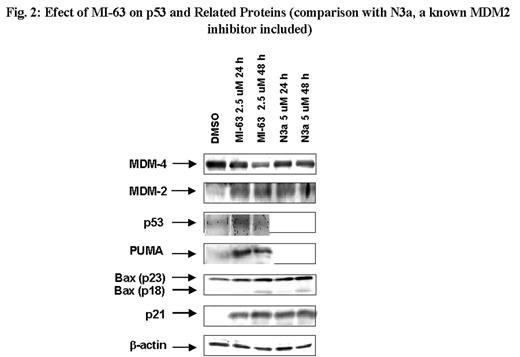Abstract
Although TP53 mutations are rare in acute myeloid leukemia (AML), inactivation of wild-type p53 protein frequently occurs through overexpression of its negative regulator MDM2 (murine double minute 2). We investigated the effects of MI-63, a small molecule that activates p53 by inhibition of MDM2-p53 interaction [ Ki value of 3 nM (
Mechanistic studies showed that MI-63 blocks G1/S phase transition in AML cells with wild-type p53 resulting in accumulation of cells in G1 phase (percentage cells inG1 phase at 24 hrs. = 88.66% vs 43.49% in cultures with DMSO control) while MI-61, a skeletally related but inactive control compound failed to do so (41.63%). Treatment with MI-63 increased cellular levels of p53 and p53 dependent proteins in OCI-AML-3 cells that include p21 and BH3-only pro-apoptotic protein Puma and pro-apoptotic multi-domain Bcl-2 family member Bax. Additionally, MI-63 induced a profound decrease in the levels of MDM4, an MDM2 homolog that has been reported to mediate resistance to the effects of nutlin-3a, suggesting that MI-63 may offer a therapeutic advantage in cells expressing high levels of MDM4.
Finally, supporting the concept that increased levels of p53 modulate the apoptotic rheostat both directly, by behaving as a BH3-only protein, and indirectly by increasing the levels of sensitizer BH3-only proteins, MI-63 potently synergized with AT-101, an orally available pan inhibitor of Bcl-2, Bcl-xL and Mcl-1 (currently being evaluated as an antitumor agent in Phase I/II trials by Ascenta Therapeutics), to induce mitochondrial dysfunction and apoptosis in OCI-AML-3 cells (average combination index = 0.055±0.019).
Taken together our results support preclinical evaluation of novel small molecule MI-63 alone and in combination with Bcl-2 inhibitors for the therapy of AML. The studies in primary AML samples are ongoing.
MI-63 Induced Apoptosis Requires Intact p53
Efect of MI-63 on p53 and Related Proteins (comparison with N3a, a known MDM2 inhibitor included)
Efect of MI-63 on p53 and Related Proteins (comparison with N3a, a known MDM2 inhibitor included)
Disclosures: Dajun Yang is an employee of Ascenta Therapeutics, Inc.; Dajun Yang has ownership interest in Ascenta Therapeutics, Inc.
Author notes
Corresponding author



